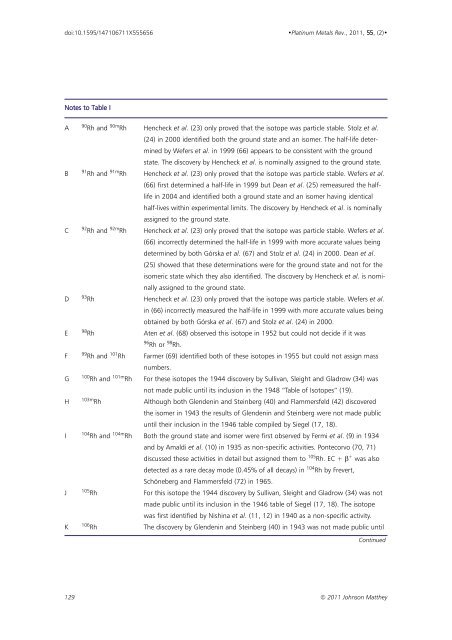Download - Platinum Metals Review
Download - Platinum Metals Review
Download - Platinum Metals Review
Create successful ePaper yourself
Turn your PDF publications into a flip-book with our unique Google optimized e-Paper software.
doi:10.1595/147106711X555656<br />
•<strong>Platinum</strong> <strong>Metals</strong> Rev., 2011, 55, (2)•<br />
Notes to Table I<br />
A<br />
B<br />
C<br />
D<br />
E<br />
90 Rh and 90m Rh Hencheck et al. (23) only proved that the isotope was particle stable. Stolz et al.<br />
(24) in 2000 identified both the ground state and an isomer. The half-life determined<br />
by Wefers et al. in 1999 (66) appears to be consistent with the ground<br />
state. The discovery by Hencheck et al. is nominally assigned to the ground state.<br />
91 Rh and 91m Rh Hencheck et al. (23) only proved that the isotope was particle stable. Wefers et al.<br />
(66) first determined a half-life in 1999 but Dean et al. (25) remeasured the halflife<br />
in 2004 and identified both a ground state and an isomer having identical<br />
half-lives within experimental limits. The discovery by Hencheck et al. is nominally<br />
assigned to the ground state.<br />
92 Rh and 92m Rh Hencheck et al. (23) only proved that the isotope was particle stable. Wefers et al.<br />
(66) incorrectly determined the half-life in 1999 with more accurate values being<br />
determined by both Górska et al. (67) and Stolz et al. (24) in 2000. Dean et al.<br />
(25) showed that these determinations were for the ground state and not for the<br />
isomeric state which they also identified. The discovery by Hencheck et al. is nominally<br />
assigned to the ground state.<br />
93 Rh Hencheck et al. (23) only proved that the isotope was particle stable. Wefers et al.<br />
in (66) incorrectly measured the half-life in 1999 with more accurate values being<br />
obtained by both Górska et al. (67) and Stolz et al. (24) in 2000.<br />
98 Rh Aten et al. (68) observed this isotope in 1952 but could not decide if it was<br />
96 Rh or 98 Rh.<br />
F<br />
99 Rh and 101 Rh Farmer (69) identified both of these isotopes in 1955 but could not assign mass<br />
numbers.<br />
G<br />
100 Rh and 101m Rh For these isotopes the 1944 discovery by Sullivan, Sleight and Gladrow (34) was<br />
not made public until its inclusion in the 1948 “Table of Isotopes” (19).<br />
H<br />
I<br />
J<br />
103m Rh<br />
Although both Glendenin and Steinberg (40) and Flammersfeld (42) discovered<br />
the isomer in 1943 the results of Glendenin and Steinberg were not made public<br />
until their inclusion in the 1946 table compiled by Siegel (17, 18).<br />
104 Rh and 104m Rh Both the ground state and isomer were first observed by Fermi et al. (9) in 1934<br />
and by Amaldi et al. (10) in 1935 as non-specific activities. Pontecorvo (70, 71)<br />
discussed these activities in detail but assigned them to 105 Rh. EC + β + was also<br />
detected as a rare decay mode (0.45% of all decays) in 104 Rh by Frevert,<br />
Schöneberg and Flammersfeld (72) in 1965.<br />
105 Rh For this isotope the 1944 discovery by Sullivan, Sleight and Gladrow (34) was not<br />
made public until its inclusion in the 1946 table of Siegel (17, 18). The isotope<br />
was first identified by Nishina et al. (11, 12) in 1940 as a non-specific activity.<br />
K 106 Rh The discovery by Glendenin and Steinberg (40) in 1943 was not made public until<br />
Continued<br />
129 © 2011 Johnson Matthey
















